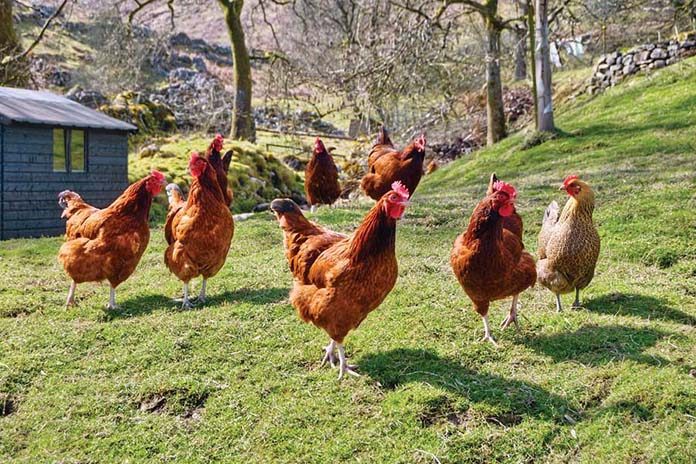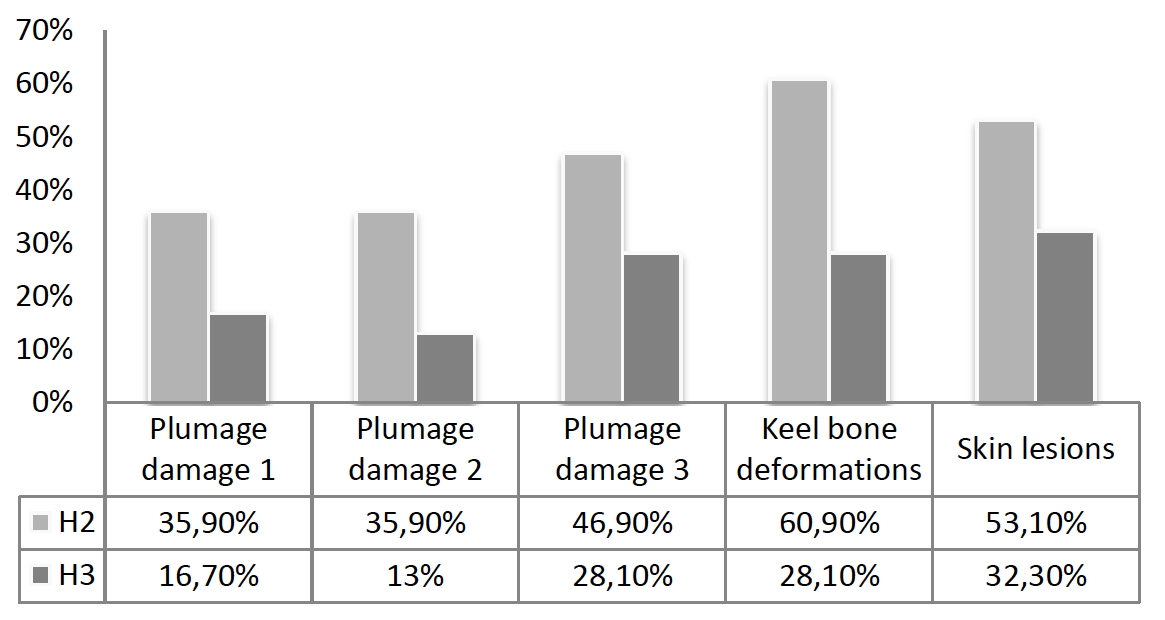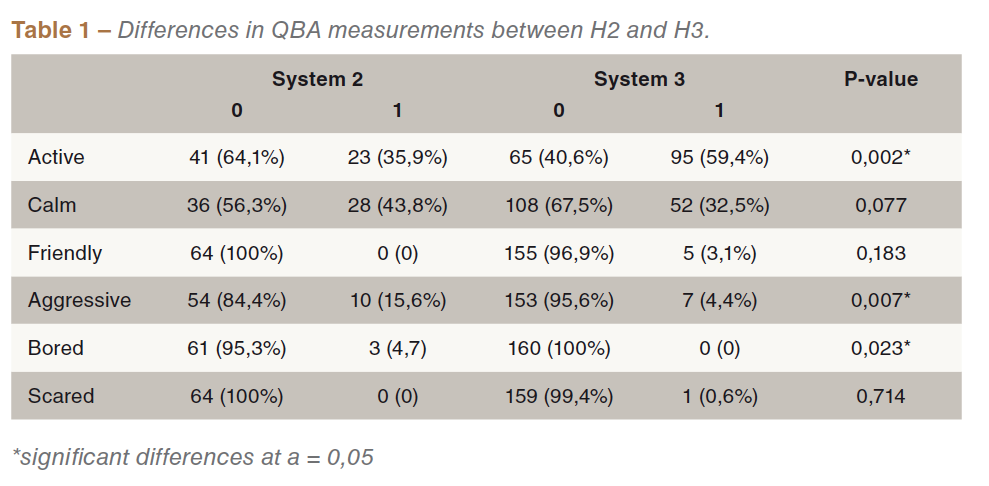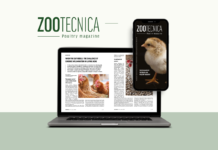
The aim of this study was to observe the improvement in welfare indicators of spent hens kept in three different housing systems.
Sixteen Isa Brown spent hens were randomly placed in enriched cages together with nine other birds (H1). After two weeks of adaptation, birds were placed in individual enriched cages (H2) for a one month period and last, they were transferred to a deep litter system (H3) for two months. Observations and measurements of welfare indicators have been made on a weekly basis according to the Welfare Quality® protocol.
The data collected was analyzed using SPSS, version 23. Significant improvement was found in most of welfare indicators from cages system vs. litter system. More specifically, severe damage to feathers of the head and neck (score = 2), was observed in H1 (56.30%) of the cases and in H2 (35.90%) while in H3 the score 2 was only given to 6.70% of the birds. Similar results were found in damage of the back feathers (50% in H1, 35.90% in H2 and 13% in H3) and the belly feathers (62.5% in H1, 46,90% in H2 and 28.10% in H3). Keel bone deformation was observed in 75% and in 28.10% of the birds in H1 and H3, respectively. Skin lesions scores improved significantly in litter system in comparison to the cages system.
Qualitative measures have shown that most of the birds have been calm but active in litter system while aggressive behaviors have been more common in cages system. Although welfare seems to be significantly improved for the spent hens moving from cages to litter system, the small number of birds used in this study cannot support general conclusions. More research is currently in progress to further investigate the options for poultry industry to add value to spent hens by improving their welfare status.
Introduction
Rearing system has an important influence on hen’s welfare and consist an issue of major concern for egg producers, consumers, researchers and policy makers. Several differences exist among housing systems while each housing system has positive and negative aspects on welfare parameters. The levels of damaged birds have been often greater for hens depopulated from furnished cages than from aviary and free range systems. Moreover, feather pecking is a common problem of laying hens and take place in all housing systems. Especially, in non–cage housing systems, feather pecking has being challenging due to its rapid spread.
Recent research studies demonstrated that spent hens have a very low economic value and this is the main reason for their treatment as a by– product of the egg industry. Those birds consists a problem for the farmers, who have to dispose of them at a cost–effectively as possible. As a result, spent hens are mishandled and their welfare status is dramatically induced. However, if those birds could have a higher value for the farmers, depopulation after the laying period would be a more cautious procedure aiming to increase the welfare status of the hens.
This has been recently recognised by researchers and action was taken to improve the welfare of end–of–laying hens and to increase the sustainability of poultry industry. The aim of this study was to identify the improvement on welfare indicators of spent hens kept in three different housing systems. The ultimate purpose is to define practices that can be applied both to improve the welfare status of those birds and to increase their economic value.
Materials and methods
In this experiment, sixteen 2-year–old Isa Brown spent hens (end–of–lay hens) were used. The experiment took place in the experimental research facilities of Aristotle University in accordance to European law laying down minimum standards for the protection of laying hens (EU,1999).
Sixteen Isa Brown spent hens were randomly placed in enriched cages together with nine other birds (H1). After two weeks of adaptation, birds were placed in individual enriched cages (H2) for a one month period and last, they were transferred to a deep litter system (H3) for two months.
Observations and measurements of welfare indicators have been made on a weekly basis according to the Welfare Quality® protocol. A series of animal–based measures was taken for each bird as following:
- plumage damage: measures on 3 body parts (head and neck, belly and back and rump together) on a 3–point scale (0 = complete feathering, 1 = moderate wear, 2 = extent);
- keel bone deformation: inspection of the keel area and assessed in two categories (0 = no evidence and 2 = deviations or deformations);
- skin lesions: observation on the whole body on a 3 point scale (0 = no lesions, 1 = moderate and 2 = extent);
- QBA was performed with an observation of birds from a distance and was categorized in positive and negative expressions.
Descriptive and inferential statistical methods were applied at a significance level a=0.05 using SPSS, version 23.

Results and discussion
Data analysis showed that welfare parameters differed among housing systems. As expected, a strong–positive improvement was found for most of animal–based measurements in H3. The aim of this study was to observe the improvement on welfare indicators of spent hens kept in three different housing systems.
The percentage of score 0 in all 3 body parts significantly (P≤0,05) increased among systems. On the body part of the head and neck in H1 score 0 was given to only 6,30% of the birds and was observed higher in H2 for the 21,90% and in H3 for the 62% of the cases. Similar results were found in the parts of the back (0% in H1, 9% in H2 and 49% in H3) and of the belly (0% in H1, 14% in H2 and 58% in H3). On the other hand, a reduction (P≤0,05) of score 2 was observed among the systems in all body parts (P≤0,05).
More specifically, feathers of the head and neck were more damaged in H1 (56.30%) of the cases and in H2 (35.90%) while in H3 the score 2 was only given to 6.70% of the birds. Similar results were found in damage of the back and rump feathers (50% in H1, 35.90% in H2 and 13% in H3) and the belly feathers (62.5% in H1, 46,90% in H2 and 28.10% in H3). The results of this experiment demonstrated that there were significant differences in plumage damage in the different housing systems. This also was supported by similar studies. Data on plumage damage showed that in litter system (H3) the scores were better on all body parts in comparison to cage systems. Sherwin et al. (2010) found that feather damage was in a high incidence in end–of–lay period.
In H1, most of the hens had some feather damage on all body parts, however the plumage was improved strongly in deep litter system. According to Sherwin hens housed in a free–range system had the lowest feather damage compared to other systems. Free–range housing systems provide hens with more free space similar to the deep litter system, in which we also found better plumage condition. Also, Heerkens et al. (2015) confirms that providing access to a free–range area had a positive effect on plumage condition. According to Rodenburg et al. (2005) when hens are kept in large groups, as in the aviary systems, feather pecking is more difficult to control. Previous studies also found differences in plumage scores between different housing systems although they gave different approaches such as the flooring material.
Similar results were observed on keel bone deformation and skin lesions between three systems. Score 0 for keel bone was given in H1 to 25% of the hens and in H2 for 39,10% while in H3 keel bone was completely straight for 71,9% of the birds. Keel bone deformation (score 2) was observed in 75% of the birds in H1 and in 28,10% in H3. Skin lesions (score 2) were found in H1 56,30% of the birds, which improved in H3 32,30%. Data on keel bone deformations differed between previous studies which shown that laying hens housed in non–cage systems are at a higher risk for keel bone damage because of the increased freedom of movement and access to litter. The results of this experiment demonstrated that hens in cage systems had more serious deformations.
In Figure 1, the frequencies of score “2” in H2 and H3 are presented together with the statistical significance of the differences at a=0,05.
In Table 1 the frequencies in QBA measurements between H2 and H3 are presented together with the statistical significance of the differences at a=0,05.
Qualitative measures have shown that most of the birds have been active in litter system. As mentioned above, the results on QBA indicate more significant (P≤0,05) evidence of active birds in H3 compared to H2. On the other hand, we found a small percentage of aggressive behavior in systems under study but in cage system the percentage was significantly (P≤0,05) higher i.e. in 15,60% of the cases in comparison to 4,40% in litter system. In addition, in deep litter system little evidence of friendly behaviour was found. This tendency was in agreement with results from previous studies in which non–cage housing systems have been presented as more animal–friendly compared to cage systems, because the hens have more space to perform natural behaviors. Also, according to the freedom to express normal behavior was better secured in non–cage systems. Furthermore, ‘bored’ birds were found to be more in cage systems than in deep litter system (P≤0,05).
Conclusions
In conclusion, this study indicates that the welfare of spent hens maybe significantly improved moving from cages to litter system. This could be a proposal to egg–industry to improve the sustainability of the sector. However, the small number of birds used for the experiment cannot support general conclusions. More research is currently in progress to further investigate the options for poultry industry to add value to spent hens by improving their welfare status and increasing their economic value.


















